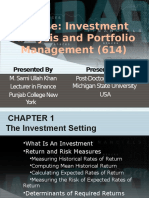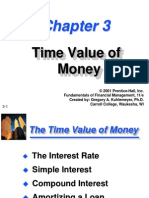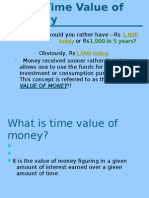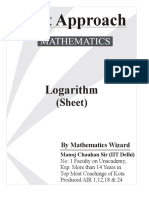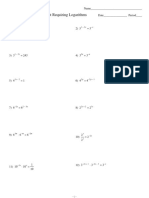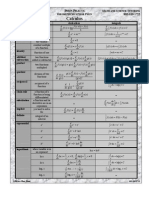Time Value of Money
Time Value of Money
Uploaded by
johnnyboy30003223Copyright:
Available Formats
Time Value of Money
Time Value of Money
Uploaded by
johnnyboy30003223Original Description:
Copyright
Available Formats
Share this document
Did you find this document useful?
Is this content inappropriate?
Copyright:
Available Formats
Time Value of Money
Time Value of Money
Uploaded by
johnnyboy30003223Copyright:
Available Formats
Chapter 5
The Time Value of Money
Learning Objectives
1. Explain what the time value of money is and why it is so important in the field of finance.
2. Explain the concept of future value, including the meaning of principal amount, simple
interest, and compound interest, and be able to use the future value formula to make business
decisions.
3. Explain the concept of present value and how it relates to future value, and be able use the
present value formula to make business decisions.
4. Discuss why the concept of compounding is not restricted to money, and be able to use the
future value formula to calculate growth rates.
I. Chapter Outline
5.1 The Time Value of Money
A basic problem faced by managers in financial decision making is to determine the value of a
series of future cash flows, whether paying for an asset or evaluating a project.
The question that is being raised is: What is the value of the stream of future cash flows today?
We refer to this value as the time value of money.
Understanding time value of money concepts and calculations will enable us to evaluate the trade-
off between cash flows today and cash flows at some future point in time.
The basic variables in time value of money calculations when we are dealing with lump sum
(single) cash flows) are present value (PV), future value (FV), interest rate or rate of return (i), and
time periods (n). If we know any three of the four basic variables, we can easily solve for the
missing variable. We will also introduce a fifth variable, (m), which is defined as the number of
compounding/discounting periods per year.
Time value of money calculations can be made using formulas, calculators, or spreadsheets.
Selected links to Time Value of Money online resources:
o http://www.tvmcalcs.com/tvm/tvm_intro
o http://www.studyfinance.com/lessons/timevalue/index.mv
o http://www.frickcpa.com/tvom/default.asp
A. Consuming Today or Tomorrow
People prefer to consume goods today rather than wait to consume similar goods in the
futurethat is, a positive time preference.
The time value of money is based on the belief that people have a positive time
preference for consumption.
Money has a time value because a dollar in hand today is worth more than a dollar to
be received in the future. The dollar in hand could be either invested to earn interest or
spent today.
The value of a dollar invested at a positive interest rate grows over time, and the
further in the future you receive a dollar, the less it is worth today.
The trade-off between spending the money today versus spending the money at
some future date depends on the rate of interest you can earn by investing. The
higher the interest rate, the more the likelihood of consumption being deferred.
B. Time Lines as Aids to Problem Solving
They are an easy way to visualize the cash flows associated with investment decisions.
A timeline is a horizontal line that starts at time zero (today) and shows cash flows as
they occur over time. See Exhibit 5.1
It is conventional to show that all cash outflows are given a negative value; then all
cash inflows must have a positive value.
C. Future Value versus Present Value
Financial decisions are evaluated on either a future value basis or a present value basis.
Future value measures what one or more cash flows are worth at the end of a specified
period, while present value measures what one or more cash flows that are to be
received in the future will be worth today (at t = 0).
The process of converting an amount given at the present time into a future value is
called compounding. It is the process of earning interest over time.
Discounting is the process of converting future cash flows to what its present value is.
In other words, present value is the current value of the future cash flows that are
discounted at an appropriate interest rate.
5.2 Future Value and Compounding
A. Single-Period Investment
We can determine the value of an investment at the end of one period (whether it is a
month, quarter or year) if we know the interest rate to be earned by the investment.
If you invest for one period at an interest rate of i, your investment, or principal, will
grow by (1 + i) per dollar invested.
The term (1+ i) is the future value interest factoroften called simply the future
value factor.
B. Two-Period Investment
A two-period investment is simply two single-period investments back-to-back.
When more than one period is considered, we need to recognize that after the first
period, interest accrues on both the original investment (principal) and the interest
earned in the preceding periods.
The principal is the amount of money on which interest is paid.
Simple interest is the amount of interest paid on the original principal amount only.
With compounding, you are able to earn compound interest, which consists of both
simple interest and interest-on-interest.
C. The Future Value Equation
Equation 5.1 gives us the general equation to find the future value after any number of
periods.
) i + 1 PV( = FV
n
n
The term (1 + i)
n
is the future value factor.
We can use future value tables to find the future value factor at different interest rates
and maturity periods. Or we can use any calculator that has a power key (the y
x
key)
can be used to make this computation.
Future value of a lump sum (annual compounding)
Example: You deposit $100 in the bank. The bank offers you an interest rate of 10%. If you make no
additional deposits or withdrawals, what is your account balance at the end of five years?
In this example, the present value (PV) is $100, the interest rate (i) is 10%, the time period (n) is 5
years, and you are asked to solve for the future value (FV).
Formula approach: ) i + 1 PV( = FV
n
n
FV
5
= $100(1.10)
5
= $100(1.61051) = $161.05
Had the bank offered us simple interest on our deposit, or if we had withdrawn the interest each
year, we would have withdrawn a total of (PV x i) or $10 each year and our account balance
would be equal to the amount we originally deposited, $100.
We can also use interest tables to solve the problem.
FV
n
= PV(FVIF
i,n
) =
Note: FVIF
i,n
= (1 + i)
n
and is referred to as the Future Value Interest Factor for i interest
rate and n periods. In general, the use of interest tables is not recommended due to the fact
that the interest factors are rounded off, and in addition, the tables are not useful for fractional
interest rates and/or time periods.
Financial calculator - Make sure that your calculator is set for 1 P/YR. Enter cash outflows as
a negative number:
n I PV CF FV
N I/YR PV PMT FV
FV
190
= $100(1.05)
190
=
D. Compounding More Frequently Than Once a Year
The more frequently the interest payments are compounded, the larger the future value
of $1 for a given time period. See Equation 5.2.
( ) i/m 1 PV = FV
n m
n +
Future value of a lump sum (non-annual compounding)
Example: You deposit $100 in the bank. The bank offers you an interest rate of 10%, compounded
quarterly. If you make no additional deposits or withdrawals, what is your account balance at the end
of five years?
In this example, the present value (PV) is $100, the interest rate (i) is 10%, the time period (n) is 5
years, the number of compounding periods per year (m) are 4, and you are asked to solve for the
future value (FV).
Formula approach: ( ) i/m 1 PV = FV
n m
n +
FV
5
=
Financial calculator - Make sure that your calculator is set for 1 P/YR and that you enter the
total periods
(n x m) and the periodic (i/m) interest rate. Enter cash outflows as a negative number:
n x m i/m PV CF FV
N I/YR PV PMT FV
When interest is compounded on a continuous basis, we can use Equation 5.3.
( )
n i
n e PV = FV
Example: You deposit $100 in the bank. The bank offers you an interest rate of 10%, compounded
continuously. If you make no additional deposits or withdrawals, what is your account balance at the
end of five years?
In this example, the present value (PV) is $100, the interest rate (i) is 10%, the time period (n) is 5
years, the number of compounding periods per year (m) are infinite, and you are asked to solve for the
future value (FV).
Formula approach: ( )
n i
n e PV = FV
FV
5
=
Note: e is the base of natural logarithms, and should be used when the interest rate is
compounded continuously. You can use 2.71828 as an approximation or use your calculator to
return the value (1 e
x
). If you would like to see the proof, click here. Click here if you
wish to see e computed to a few more decimal places!
5.3 Present Value and Discounting
Present value calculations involve bringing a future amount back to the present.
This process is called discounting, and the interest rate i is known as the discount rate.
The present value (PV) is often called the discounted value of future cash payments.
The present value factor is more commonly called the discount factor.
Equation 5.4 gives us the general equation to find the present value after any number of
periods.
( )
n
n
i 1
FV
= PV
+
or ) i + 1 ( FV = PV
-n
n
The further in the future a dollar will be received, the less it is worth today.
The higher the discount rate, the lower the present value of a dollar.
Present value of a lump sum (annual compounding)
Example: You wish to have a total of $2,500 at the end of three years. If you can earn an interest rate
of 7%, how much must you invest today?
In this example, the future value (FV) is $2,500, the interest rate (i) is 7%, the time period (n) is 3
years, and you are asked to solve for the present value (PV).
Formula approach:
( )
n
n
i 1
FV
= PV
+
or ) i + 1 ( FV = PV
-n
n
[To make the exponent negative, use the (+/-) or (CHS) key on your calculator]
PV =
We can also use interest tables to solve the problem.
PV = FV
n
(PVIF
i,n
) =
Note: PVIF
i,n
= (1 + i)
-n
and is referred to as the Present Value Interest Factor for i interest
rate and n periods. In general, the use of interest tables is not recommended due to the fact
that the interest factors are rounded off, and in addition, the tables are not useful for fractional
interest rates and/or time periods.
Financial calculator - Make sure that your calculator is set for 1 P/YR. Enter cash outflows as
a negative number:
n i PV CF FV
N I/YR PV PMT FV
Present value of a lump sum (non-annual discounting)
Example: You wish to have a total of $2,500 at the end of three years. If you can earn an interest rate
of 7%, compounded daily, how much must you invest today?
In this example, the future value (FV) is $2,500, the interest rate (i) is 7%, the number of
compounding periods per year (m) is 365, the time period (n) is 3 years, and you are asked to solve for
the present value (PV).
Formula approach:
( )
n m
n
i/m 1
FV
= PV
+
or ( ) i/m 1 FV = PV
n m -
n +
PV =
Financial calculator - Make sure that your calculator is set for 1 P/YR and that you enter the
total periods
(n x m) and the periodic (i/m) interest rate. Enter cash outflows as a negative number:
n x m i/m PV C FV
N I/YR PV PMT FV
Present value of a lump sum (continuous discounting)
Example: You wish to have a total of $2,500 at the end of three years. If you can earn an interest rate
of 7%, compounded continuously, how much must you invest today?
In this example, the future value (FV) is $2,500, the interest rate (i) is 7%, the number of
compounding periods per year (m) is infinite, the time period (n) is 3 years, and you are asked to solve
for the present value (PV).
Formula approach:
( )
n i
n
e
FV
= PV
or
( )
n i -
n e FV PV
PV =
5.3 Additional Concepts and Applications
A. Finding the Interest Rate
In Finance, a number of situations will require you to determine the interest rate (or
discount rate) for a given stream of future cash flows.
For an individual investor or a firm, it may be necessary to determine:
the return on an investment.
the interest rate on a loan
a growth rate.
Determining the interest/discount rate (i) in a lump sum situation (annual compounding)
Example: You invested $3,000 in a mutual fund ten years ago. The investment is now worth a total of
$7,500. What is your compounded annual rate of return on this investment?
In this example, the present value (PV) is $3,000, the future value (FV) is $7,500, the time period (n)
is ten years, and you are asked to solve for the interest/discount rate (i).
Formula approach: 1 -
PV
FV
= i
n
1/n
,
_
i =
Financial calculator - Make sure that your calculator is set for 1 P/YR. Enter cash outflows as
a negative number:
n i PV CF FV
N I/YR PV PMT FV
Determining the interest/discount rate (i) in a lump sum situation (non-annual compounding)
Example: You deposited $3,000 in a bank ten years ago. Your account balance is now $7,500. What
was your compounded annual rate of return on this deposit assuming the bank offered semi-annual
compounding?
In this example, the present value (PV) is $3,000, the future value (FV) is $7,500, the number of
compounding periods per year (m) are 2, the time period (n) is ten years, and you are asked to solve
for the interest/discount rate (i).
Formula approach:
1
1
]
1
,
_
1 -
PV
FV
m = i
n
n) 1/(m
i =
Financial calculator - Make sure that your calculator is set for 1 P/YR and that you enter the
total periods
(n x m). Since this will return a periodic rate, you must multiply your answer by (m) to obtain
the yearly rate. Enter cash outflows as a negative number:
n x m i/m PV CF FV
N I/YR PV PMT FV
Determining the interest/discount rate (i) in a lump sum situation (continuous compounding)
Formula approach:
n
/PV) (FV ln
= i
n
[ln stands for the natural logarithm . You can use either the ln or log button on your calculator]
i =
Determining the time period (n) in a lump sum situation (annual compounding)
Example: You wish to save $2,000 for a down payment on a new car that you will purchase in three
years. You currently have $1,600 in your bank account earning a return of 7%. How long will it take
you to accumulate the sum you need for the down payment?
In this example, the present value (PV) is $1,600, the future value (FV) is $2,000, the interest
(discount) rate (i) is 7%, and you are asked to solve for the time period (n).
Formula approach:
) i + (1 ln
/PV) (FV ln
= n
n
n =
Financial calculator - Make sure that your calculator is set for 1 P/YR. Enter cash outflows as
a negative number:
n i PV CF FV
N I/YR PV PMT FV
Determining the time period (n) in a lump sum situation (non-annual compounding)
Example: You wish to save $2,000 for a down payment on a new car that you will purchase in three
years. You currently have $1,600 in your bank account earning a return of 7%, compounded monthly.
How long will it take you to accumulate the sum you need for the down payment?
In this example, the present value (PV) is $1,600, the future value (FV) is $2,000, the interest
(discount) rate (i) is 7%, the number of compounding periods per year (m) is 12, and you are asked to
solve for the number of time periods (n).
Formula approach:
i/m) (1 ln m
/PV) FV ( ln
= n
n
+
n =
Financial calculator - Make sure that your calculator is set for 1 P/YR and that you enter the
periodic (i/m) interest rate. Since this will return the total periods, you must divide your
answer by (m) to obtain the answer in years. Enter cash outflows as a negative number:
n x m i/m PV CF FV
N I/YR PV PMT FV
Determining the time period (n) in a lump sum situation (continuous compounding)
Formula approach:
i
/PV) (FV ln
= n
n
n =
B. The Rule of 72
People use rules of thumb to approximate difficult present value calculations.
One such rule is the Rule of 72, which can be used to determine the amount of time it
takes to double an investment.
The Rule of 72 says that the time to double your money (TDM) approximately equals
72/i, where i is expressed as a percentage.
The rule is fairly accurate for interest rates between 5 and 20 percent.
C. Compound Growth Rates
Compound growth occurs when the initial value of a number increases or decreases
each period by the factor (1 + growth rate). Such changes over time include the
population growth rate of a city, or the sales or earnings growth rate of a firm.
The Power of Compounding
These figures are based on an assumed annual rate of return of 10 percent, with no withdrawals and no
taxes. Whether these conditions are attainable or desirable is beside the point. This table merely illustrates
a principal that's based purely on mathematics. Assuming the same rate of return (10 percent) in each of
the two examples, a person who invests early and for just eight years will have more money at 65 years
old than will someone who starts late and invests for nearly 40 years. Naturally, someone who starts early
and doesn't stop has the potential to do much better than either of these examples.
Example 1: Example 2:
Age
Annual
Investment
Year-End
Value
Annual
Investment
Year-End
Value
19 $ 2,000 $2,200 $ 0 $ 0
20 $ 2,000 $4,620 $ 0 $ 0
21 $ 2,000 $7,282 $ 0 $ 0
22 $ 2,000 $10,210 $ 0 $ 0
23 $ 2,000 $13,431 $ 0 $ 0
24 $ 2,000 $ 16,974 $ 0 $ 0
25 $ 2,000 $ 20,872 $ 0 $ 0
26 $ 2,000 $ 25,159 $ 0 $ 0
27 $ 0 $ 27,675 $2,000 $2,200
28 $ 0 $ 30,442 $2,000 $4,620
29 $ 0 $33,487 $2,000 $7,282
30 $ 0 $36,835 $2,000 $10,210
31 $ 0 $40,519 $2,000 $13,431
32 $ 0 $44,571 $2,000 $16,974
33 $ 0 $49,028 $2,000 $20,872
34 $ 0 $53,931 $2,000 $25,159
35 $ 0 $59,324 $2,000 $29,875
36 $ 0 $65,256 $2,000 $35,062
37 $ 0 $71,782 $2,000 $40,769
38 $ 0 $78,960 $2,000 $47,045
39 $ 0 $86,856 $2,000 $53,950
40 $ 0 $95,541 $2,000 $61,545
41 $ 0 $105,095 $2,000 $69,899
42 $ 0 $115,605 $2,000 $79,089
43 $ 0 $127,165 $2,000 $89,198
44 $ 0 $139,882 $2,000 $100,318
45 $ 0 $153,870 $2,000 $112,550
46 $ 0 $169,257 $2,000 $126,005
47 $ 0 $186,183 $2,000 $140,805
48 $ 0 $204,801 $2,000 $157,086
49 $ 0 $225,281 $2,000 $174,995
50 $ 0 $247,809 $2,000 $194,694
51 $ 0 $272,590 $2,000 $216,364
52 $ 0 $299,849 $2,000 $240,200
53 $ 0 $329,834 $2,000 $266,420
54 $ 0 $362,818 $2,000 $295,262
55 $ 0 $399,100 $2,000 $326,988
56 $ 0 $439,010 $2,000 $361,887
57 $ 0 $482,910 $2,000 $400,276
58 $ 0 $531,202 $2,000 $442,503
59 $ 0 $584,322 $2,000 $488,953
60 $ 0 $642,754 $2,000 $540,049
61 $ 0 $707,029 $2,000 $596,254
62 $ 0 $777,732 $2,000 $658,079
63 $ 0 $855,505 $2,000 $726,087
64 $ 0 $941,056 $2,000 $800,896
65 $ 0 $1,035,161 $,2000 $883,185
Less $ invested ($16,000) ($78,000)
$1,019,161 $805,185
Money
increased
64 fold 10 fold
Chapter 5 Sample Questions
Multiple Choice
1. Future value: Brittany Willis is looking to invest for retirement, which she hopes will be in 30 years. She is
looking to invest $38,500 today in U.S. Treasury bonds that will earn interest at 8.25 percent annually. How much
will she have at the end of 30 years?
a. $481,676.96
b. $415,238.76
c. $514,896.06
d. $365,410.11
2. Multiple compounding periods (FV): Hector Cervantes started on his first job last year and plans to save for a
down payment on a house in 4 years. He will be able to invest $33,000 today in a money market account that will
pay him an interest rate of 7.15 percent compounded daily. How much will he have at the end of 4 years?
a. $50,074.29
b. $55,784.52
c. $43,924.82
d. $46,560.31
3. Compounding: Trish Harris has deposited $2,500 today in an account paying 6 percent interest annually. What
would be the simple interest earned on this investment in five years? If the account paid compound interest, what
would be the interest-on-interest in five years?
a. $750; $95.56
b. $150; $845.56
c. $150; $95.56
d. $95.56; $845.56
4. Present value: John Hsu wants to start a business in 10 years. He hopes to have $250,000 at that time to invest in
the business. To reach his goal, he plans to invest a certain amount today in a bank CD that will pay him 9.75
percent annually. How much will he have to invest today to achieve his target?
a. $98,604.04
b. $633,848.25
c. $87,757.60
d. $89,729.68
5. Multiple compounding (PV): Darius Miller is seeking to accumulate $97,750 in 10 years to invest in a real estate
venture. He can earn 4.22 percent annual interest with quarterly compounding in a private investment. How much
will he have invest today to reach his goal?
a. $147,784.01
b. $64,239.85
c. $59,100.66
d. $73,875.83
6. Interest rate: Ray Seo has $9,800 to invest in a small business venture. His partner has promised to pay him back
$27,400 in fifteen years. What is the return earned on this investment?
a. 8.08 percent
b. 6.81 percent
c. 9.36 percent
d. 7.09 percent
7. Growth rate: Cleargen, a detergent manufacturer, has announced this year's net income as $287,441. It expects its
net earnings to grow at a rate of 15 percent per year for the next 5 years, before dropping to 10 percent for each of
the following 2 years. What is the firm's net income after 7 years?
a. $999,667
b. $699,557
c. $670,176
d. $821,979
8. Time to attain goal: Your uncle is looking to double his investment of $10,000. He claims he can get earn 14
percent on his investment. How long will it be before he can double his investment? Use the Rule of 72 and round
to the nearest year.
a. 5 years
b. 14 years
c. 10 years
d. None of the above
9. Time to attain goal: Ryan Holmes wants to deposit $10,000 in a bank account that pays 8.15 percent annually.
How many years will it take for his investment to grow to $23,000?
a. 9.89 years
b. 10.63 years
c. 8.08 years
d. 11.27 years
10. Time to attain goal: You can deposit $1,350 today into a savings account. How long must you wait for the
investment to grow to $2,700 if you can earn 8 percent compounded continuously on this money?
a. 8.31 years
b. 8.66 years
c. 9.35 years
d. 7.01 years
Answer Section
MULTIPLE CHOICE
1. ANS: B
Present value of the investment = PV = $38,500
Return on Treasury bonds = i = 8.25%
Number of years = n = 30.
FV30 = [ $38,500 x (1 + .08)
30
] = $415,238.76
Key: N I/YR PV PMT FV
Enter: 30 8.25 -38,500 0
Solve For: 415,238.76
PTS: 1 MSC: JDK
2. ANS: C
FV4 = [ $33,000 x (1 + .0715/365)
(4x365)
] = $43,924.82
Key: N I/YR PV PMT FV
Adjustment: 4 x 365 7.15/365
Enter: 1,460 .019589041 -33,000 0
Solve For: 43,924.82
PTS: 1 MSC: JDK
3. ANS: A
Deposit today = PV = $2,500
Interest rate = i = 6%
No. of years = n = 5
Future value with simple interest:
Simple interest per year = $2,500 (0.06) = $150.00
Simple interest for 5 years = $150 x 5 = $750.00
Future value with compound interest:
FV5 = $2,500 (1 + 0.06)
5
= $3,345.56
Simple interest = $750
Interest on interest = $3,345.56 $2,500 $750 = $95.56
PTS: 1
4. ANS: A
PV = [ $250,000 / (1 + .0975)
10
] = $98,604.04
Key: N I/YR PV PMT FV
Enter: 10 9.75 0 -250,000
Solve For: 98,604.04
PTS: 1 MSC: JDK
5. ANS: B
PV = [ $97,750 / (1 + .0422/4)
(10x4)
] = $64,239.85
Key: N I/YR PV PMT FV
Adjustment: 10 x 4 4.22/4
Enter: 40 1.055 0 -97,750
Solve For: 64,239.85
PTS: 1 MSC: JDK
6. ANS: D
i = [ ($27,400/$9,800) ^ (1/15) ] - 1 = .070948 = 7.09%
Key: N I/YR PV PMT FV
Enter: 15 -9,800 0 27,400
Solve For: 7.09
PTS: 1 MSC: JDK
7. ANS: B
Current net income = PV = $287,441
Expected net income 7 years from now = FV
To calculate the expected net income, we set up the future value equation.
PTS: 1 MSC: JDK
8. ANS: A
Initial investment = $10,000
Rate of return on investment = i = 14%
Time to double the investment = TDM = 72/i = 72 / 14 = 5.14 years
PTS: 1
9. ANS: B
n = [ ln($23,000/$10,000) ] / [ ln(1 + .082) ] = 10.63 years
Key: N I/YR PV PMT FV
Enter: 8.15 -10,000 0 23,000
Solve For: 10.63
PTS: 1 MSC: JDK
10. ANS: B
n = [ ln($2,700/$1,350) ] / .08 = 8.66 years
PTS: 1 MSC: JDK NOT: Additional testbank item.
You might also like
- Abell & Braselton - Modern Differential EquationsDocument355 pagesAbell & Braselton - Modern Differential EquationsBogdan TirliNo ratings yet
- Presentation 2. Understanding The Interest Rates. The Yield To MaturityDocument30 pagesPresentation 2. Understanding The Interest Rates. The Yield To MaturitySadia SaeedNo ratings yet
- Time Value of MoneyDocument73 pagesTime Value of Moneyshakilhm100% (6)
- 3 - Cost Volume Profit AnalysisDocument1 page3 - Cost Volume Profit AnalysisPattraniteNo ratings yet
- Barings Bank Case StudyDocument2 pagesBarings Bank Case Studyjohnnyboy30003223100% (2)
- Tabulation of Error Function ValuesDocument1 pageTabulation of Error Function ValuesMatthew HaleNo ratings yet
- Logarithms Formula SheetDocument1 pageLogarithms Formula Sheetsethi75% (4)
- Time Value of MoneyDocument18 pagesTime Value of MoneyJunaid SubhaniNo ratings yet
- Time Value of MoneyDocument44 pagesTime Value of MoneyJoenna Marie Morales0% (1)
- Time Value of Money ProblemsDocument2 pagesTime Value of Money ProblemsdaveferalNo ratings yet
- Time Value of MoneyDocument16 pagesTime Value of MoneySimranNo ratings yet
- Time Value of MoneyDocument14 pagesTime Value of MoneyRakesh Gupta100% (1)
- Capital Budgeting: Should We Build This Plant?Document33 pagesCapital Budgeting: Should We Build This Plant?Bhuvan SemwalNo ratings yet
- Time Value of MoneyDocument15 pagesTime Value of MoneyMary Ann MarianoNo ratings yet
- Capital-Budgeting (Managerial Accounting)Document12 pagesCapital-Budgeting (Managerial Accounting)Dawn Juliana AranNo ratings yet
- 04 Time Value of MoneyDocument45 pages04 Time Value of MoneyGladys Dumag80% (5)
- Time Value of MoneyDocument32 pagesTime Value of MoneyHariom Singh100% (1)
- Time Value of Money FormulasDocument2 pagesTime Value of Money FormulasZubayer Hussain100% (1)
- Monetary Policy: Monetary Policy Mechanism Objectives of Monetary Policy Tools of Monetary PolicyDocument20 pagesMonetary Policy: Monetary Policy Mechanism Objectives of Monetary Policy Tools of Monetary Policysuga29No ratings yet
- Time Value of MoneyDocument60 pagesTime Value of MoneyZain AbbasNo ratings yet
- Profitability IndexDocument4 pagesProfitability Indexrahul5335No ratings yet
- The Investment Settings Chapter 1Document36 pagesThe Investment Settings Chapter 1tjsamiNo ratings yet
- Time Value of MoneyDocument52 pagesTime Value of MoneyGeorge MandaNo ratings yet
- Time Value of Money (Notes)Document13 pagesTime Value of Money (Notes)Zubair ArshadNo ratings yet
- Chapter 4 Time Value of MoneyDocument64 pagesChapter 4 Time Value of Moneysubash shresthaNo ratings yet
- The Time Value of MoneyDocument5 pagesThe Time Value of Moneysunny syNo ratings yet
- Chapter 3 Time Value of MoneyDocument103 pagesChapter 3 Time Value of Moneyaqsa_munir0% (1)
- Marginal CostingDocument30 pagesMarginal Costinganon_3722476140% (1)
- The Time Value of MoneyDocument58 pagesThe Time Value of MoneyvijayluckeyNo ratings yet
- Relationships Among Inflation, Interest Rates, and Exchange RatesDocument29 pagesRelationships Among Inflation, Interest Rates, and Exchange Ratesupf123100% (2)
- Introduction To Macroeconomics (Lecture 1)Document21 pagesIntroduction To Macroeconomics (Lecture 1)Salman HaiderNo ratings yet
- Chapter - 5 Is - LM Model Econ - 102 2Document28 pagesChapter - 5 Is - LM Model Econ - 102 2abhishekNo ratings yet
- FM 10.1 Working Cap - IntroDocument31 pagesFM 10.1 Working Cap - IntroKishlay SinghNo ratings yet
- Assignment of Time Value of MoneyDocument3 pagesAssignment of Time Value of MoneyMuxammil IqbalNo ratings yet
- Time Value of Money - TheoryDocument7 pagesTime Value of Money - TheoryNahidul Islam IUNo ratings yet
- Leverages NotesDocument9 pagesLeverages NotesAshwani ChouhanNo ratings yet
- Module 2 Time Value of MoneyDocument42 pagesModule 2 Time Value of MoneyNani MadhavNo ratings yet
- ValuationDocument23 pagesValuationishaNo ratings yet
- Lecture Notes2231 SCMDocument57 pagesLecture Notes2231 SCMhappynandaNo ratings yet
- Time Value of MoneyDocument28 pagesTime Value of Moneymich_ty100% (1)
- Bond ValuationDocument51 pagesBond ValuationRudy Putro100% (1)
- Go Study Level 1 - Time Value of MoneyDocument12 pagesGo Study Level 1 - Time Value of MoneyjojoNo ratings yet
- Aggregate Demand in The Closed Economy: 2.1. Introduction: Income-Expenditure Approach Some Important IdentitiesDocument26 pagesAggregate Demand in The Closed Economy: 2.1. Introduction: Income-Expenditure Approach Some Important IdentitiesProveedor Iptv España100% (1)
- Topic2 Risk and ReturnDocument21 pagesTopic2 Risk and ReturnMirza VejzagicNo ratings yet
- Overview of Financial ManagementDocument16 pagesOverview of Financial ManagementKAUSHIKNo ratings yet
- Cost of Capital Lecture Slides in PDF FormatDocument18 pagesCost of Capital Lecture Slides in PDF FormatLucy UnNo ratings yet
- Chap 1 - Portfolio Risk and Return Part1Document91 pagesChap 1 - Portfolio Risk and Return Part1eya feguiriNo ratings yet
- Risk and Return LectureDocument73 pagesRisk and Return LectureAJ100% (4)
- Time Value of Money: Brooks, (2013) Chapters 3, 4Document49 pagesTime Value of Money: Brooks, (2013) Chapters 3, 4DiannaNo ratings yet
- 6 International Parity Relationships and Forecasting Foreign Exchange RatesDocument57 pages6 International Parity Relationships and Forecasting Foreign Exchange Ratesreena2412No ratings yet
- Welfare EconomicsDocument4 pagesWelfare EconomicsManish KumarNo ratings yet
- The Time Value of MoneyDocument29 pagesThe Time Value of Moneymasandvishal50% (2)
- Time Value of MoneyDocument18 pagesTime Value of MoneySyed Raza100% (1)
- Time Value of MoneyDocument10 pagesTime Value of Moneyanupamamathur09100% (2)
- 9.6 Keynesian MultiplierDocument23 pages9.6 Keynesian Multiplierkimmo100% (1)
- Quantity Theory of MoneyDocument8 pagesQuantity Theory of MoneySamin SakibNo ratings yet
- Cost of CapitalDocument33 pagesCost of CapitalPrabath Suranaga Morawakage100% (2)
- Introduction To Financial ManagementDocument34 pagesIntroduction To Financial ManagementKevin OnaroNo ratings yet
- DCF ValuationDocument3 pagesDCF ValuationDurga ShankarNo ratings yet
- Capital Budgeting DecisionsDocument28 pagesCapital Budgeting Decisionsravidara470No ratings yet
- Chapter 3 FMDocument79 pagesChapter 3 FMHananNo ratings yet
- Chapter 4Document50 pagesChapter 422GayeonNo ratings yet
- DHA-BHI-404 - Unit4 - Time Value of MoneyDocument17 pagesDHA-BHI-404 - Unit4 - Time Value of MoneyFë LïçïäNo ratings yet
- Seaport Village: Bayview DiningDocument1 pageSeaport Village: Bayview Diningjohnnyboy30003223No ratings yet
- Sway GuitarDocument2 pagesSway Guitarjohnnyboy30003223No ratings yet
- P239 Dak WS08Document1 pageP239 Dak WS08johnnyboy30003223No ratings yet
- Medbak Insert KitDocument2 pagesMedbak Insert Kitjohnnyboy30003223No ratings yet
- 04 The Value PropositionDocument7 pages04 The Value Propositionjohnnyboy30003223No ratings yet
- Exponentials and LogsDocument20 pagesExponentials and Logssonukbvr369No ratings yet
- Worksheet 1 Memorandum Exponents and Surds Grade 11 MathematicsDocument6 pagesWorksheet 1 Memorandum Exponents and Surds Grade 11 Mathematicsramadimetjha68No ratings yet
- Books Doubtnut Question BankDocument51 pagesBooks Doubtnut Question BankRishav prakashNo ratings yet
- MSM 111 - Exponential and Logarithmic Functions - T5Document2 pagesMSM 111 - Exponential and Logarithmic Functions - T5Chileshe SimonNo ratings yet
- 01 Logarithm - SheetDocument20 pages01 Logarithm - SheetSarthak Bansal100% (1)
- MMW FinalDocument13 pagesMMW FinalPerbielyn BasinilloNo ratings yet
- Pi UnleashedDocument288 pagesPi UnleashedJavier100% (9)
- Lecture 29 Exponential Function - 446459516Document6 pagesLecture 29 Exponential Function - 446459516Jannatul FerdousNo ratings yet
- MathDocument148 pagesMathNoel nmh100% (1)
- Common Math SymbolsDocument6 pagesCommon Math SymbolsquocchinhNo ratings yet
- Chi-Squared Distribution TableDocument1 pageChi-Squared Distribution TablePravallika Kollipara33% (3)
- Problem Set On Hyperbolic FunctionDocument4 pagesProblem Set On Hyperbolic FunctionEDWINNo ratings yet
- 1.11 Exponential Growth and DecayDocument24 pages1.11 Exponential Growth and DecayJalpa TrivediNo ratings yet
- PYTHON AssignmentDocument26 pagesPYTHON Assignmentprincekumar13785No ratings yet
- Modern MathDocument51 pagesModern MathLurenne De CastroNo ratings yet
- Logarithm DPPDocument6 pagesLogarithm DPPMohini Devi100% (2)
- Voluntary Worksheet - Logarithms Expand Condense Properties EquationsDocument9 pagesVoluntary Worksheet - Logarithms Expand Condense Properties EquationsschengalvaNo ratings yet
- Exponential Equations Not Requiring Logarithms PDFDocument4 pagesExponential Equations Not Requiring Logarithms PDFJulian Cordero Arroyo100% (1)
- CalculusDocument2 pagesCalculusdissipog1932No ratings yet
- Logarithmp65 613 PDFDocument6 pagesLogarithmp65 613 PDFpratap75% (4)
- Standard Normal TableDocument1 pageStandard Normal TablePriyaa Tharasini A/p MurugiahNo ratings yet
- Mod-06.turunan Fungsi TrigonometriDocument16 pagesMod-06.turunan Fungsi TrigonometriArief Ageng H.No ratings yet
- Most integration_formulasDocument5 pagesMost integration_formulasAnkitMishraNo ratings yet
- Chapter 7&8 PRACTICE Test - Exponentials & Logarithms (ID-B)Document9 pagesChapter 7&8 PRACTICE Test - Exponentials & Logarithms (ID-B)Raeen NajafikhahNo ratings yet
- F6 DSE08 Exp & Log FunctionsDocument19 pagesF6 DSE08 Exp & Log Functions5G 11 Lam Hiu Nam Jolie 林曉楠 (21-22)No ratings yet
- MATH30-1 Unit 2 - Lecture Notes: Homework Listing Textbook Sections Question Numbers WorksheetsDocument40 pagesMATH30-1 Unit 2 - Lecture Notes: Homework Listing Textbook Sections Question Numbers WorksheetsBecca BobsterNo ratings yet
- 2 Define Six Sigma Fundamentals v10 3Document36 pages2 Define Six Sigma Fundamentals v10 3Kefin TajebNo ratings yet





















